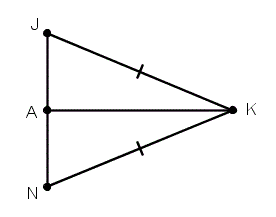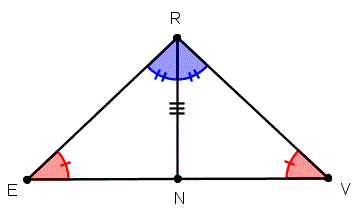Name the method used to prove the triangles are congruent.
SAS
Name the five ways to prove triangles are congruent.
SSS, SAS, AAS, ASA, SSA (with the opposite side of given angle is longer)
Name what CPCTC stands for
Corresponding Parts of Congruent Triangles are Congruent.
When geometric shape is flipped across a line and what is the line called?
reflection and line of reflection
Something that cuts a geometric object into two equal parts
bisector
If so, name the method.
Yes and ASA
Name the reason that segment KA is congruence to segment KA.
The segments are congruent to themselves.
Name the important feature to remember when naming corresponding angles?
Write then in corresponding order
Two lines that meet at a right angle
perpendicular lines
Yes or No? Is it possible to prove the triangles above are congruent by ASA?
no (should be SSS)
Name the reason used to prove
angle
ACB is congruent to
angle
ECD.
The vertical angle theorem.

AK is the angle bisector of angle JKN. Name the two congruent angles in corresponding order.
angleJKA congangleNKA
When a geometric shape is moved in a circular motion
rotation
A line that intersects two parallel lines
transversal
triangle ABC congtriangleJKI
Name what must be written in the given statement to use the reason alternate interior angles theorem to prove two angles are congruent.
parallel lines
Theorem
When a geometric figure is increased or decreased in size
dilation
all corresponding angles are congruent and all corresponding sides are proportional.

Using the markings on the triangles name the method used to prove the triangles are congruent and write a congruence statement.
AAS
triangleENR congtriangleVNR
Name the two methods that don't work to prove triangles are congruent.
AAA and SSA (with opposite side of given angle is shorter)
What theorem does this statement show?
In triangleFGH,
if bar(FG) cong bar(HG),
then angleH cong angleF.
Isosceles Triangle Theorem
This is preserved in all rigid transformations (except dilation)
size
Rectangles and isosceles trapezoids have this feature in common
congruent diagonals